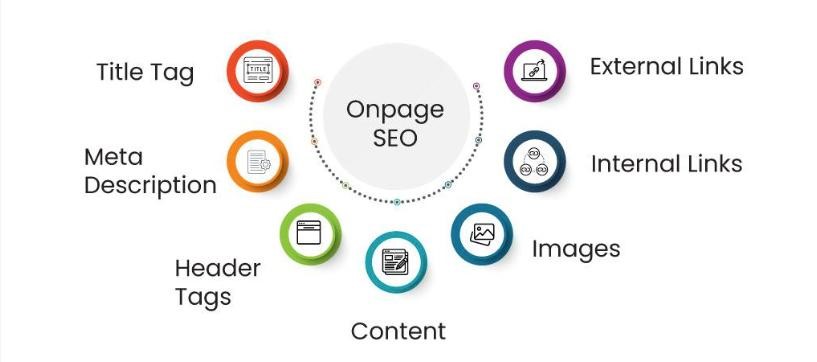This On-Page SEO comprehensive guide will walk you through the essential techniques and best practices for optimizing your website’s content, structure and design to rank higher on search engine results pages (SERPs). Have a look also on Technical SEO.
What is On-Page SEO
The practice of improving specific web pages to enhance their search engine rankings and attract targeted traffic involves optimizing both the HTML source code and content of each page

The Importance of On-Page SEO
- Improves Search Engine Rankings: Optimized pages have a higher likelihood of appearing at the top of search results, leading to increased organic traffic.
- Enhances User Experience: Well-organized, relevant, and high-quality content increases user engagement and satisfaction.
- Increases Click-Through Rates: Optimized title tags and meta descriptions can attract more clicks from search engine results pages.
- Enhances Content Relevance: By incorporating relevant keywords and providing valuable content, pages better meet the search intent of visitors.
- Facilitates Better Indexing: Proper use of tags, keywords, and internal links helps search engines understand and index your content more effectively.
On-Page SEO Techniques for Higher Rankings
- Keyword Research and Optimization: Conduct thorough research to find relevant keywords for your content. Use these keywords in titles, headings, meta descriptions, and content.
- High-Quality Content: Create informative, engaging content that comprehensively addresses user queries, focusing on relevance and quality to maintain visitor interest.
- Meta Tags Optimization: Craft compelling meta titles and descriptions that incorporate targeted keywords to encourage clicks from search engine results pages (SERPs).
- URL Structure: Utilize concise and descriptive URLs containing relevant keywords that are easy for both users and search engines to comprehend, avoiding complex, lengthy URLs.
- Header Tags: Structure content with appropriate header tags (H1, H2, H3, etc.) and naturally integrate keywords within these headers to enhance readability and SEO.
- Image Optimization: Optimize images with descriptive file names and alt text that include pertinent keywords, aiding search engines in understanding image content.
- Internal Linking: Link to related pages within your site to facilitate navigation and distribute link authority across your pages.
- Page Speed Optimization: Ensure fast page loading times by optimizing images, utilizing browser caching, and minimizing unnecessary code, which is critical for both user experience and SEO.
- Mobile-Friendliness: Design your website to be responsive and easily accessible on mobile devices to enhance user experience and comply with SEO standards.
- User Experience (UX): Focus on creating a smooth, intuitive user experience through clear navigation, effective calls-to-action, and an appealing design that encourages engagement and reduces bounce rates.
Key Components of On-Page SEO
1.Header Tags
- H1 Tag: Use an H1 tag for the main headline or title of the page. It should clearly indicate the primary topic of the content.
- H2 to H3 Subheadings: Use H2 tags for section headings and H3 tags for subsections to organize your content logically.
- Keywords: Incorporate relevant keywords into headings to indicate to search engines the topics covered in detail on the page.
2. Meta Descriptions and Title Tags
Meta Descriptions
- Keywords: Incorporate relevant keywords naturally; avoid excessive keyword usage. While they may not directly impact rankings, keywords in meta descriptions can influence click-through rates (CTR).
- Length: Keep meta descriptions within 160 characters to ensure they display correctly in SERPs. Use compelling language to encourage visitors to click through to your website.
- Call to Action (CTA): Consider adding a call to action (CTA) to prompt users to visit your website or explore further.
Title Tags
- Keywords: Incorporate essential keywords that are similar to the page’s content. This helps search engines understand the subject and context of your page.
- Length: Aim to keep title tags under 60 characters to ensure they display fully on search engine results pages (SERPs).
- Relevance: Ensure the title tag accurately summarizes the page’s content to enhance click-through rates (CTR) from search results.
3.Internal Linking
Objective:
- Facilitate user navigation by linking to pertinent pages or content within your website.
- Promote longer user engagement and enhance overall user experience (UX).
- SEO: Distribute link equity throughout your website to assist search engines in discovering and indexing more pages effectively.
- Use descriptive anchor text that accurately reflects the content of the linked page. Avoid generic phrases such as “click here.”
4.Content Optimization
Multimedia
- Images: Utilize high-quality photos that enhance the text. Compressing images improves optimization and accelerates page loading.
- Videos: Incorporate pertinent clips to boost engagement and provide additional explanations or demonstrations.
- Infographics: Use visual representations to effectively communicate intricate information or data in an accessible format.
Quality and Relevance
- Uniqueness: Offer unique and valuable content to your audience, avoiding plagiarism from other sources.
- Depth: Strive to provide thorough information that answers all user queries and delves deeply into the topic.
- Keyword Integration: Naturally include keywords throughout your content, focusing on semantic keywords and their variations to enhance relevance without excessive optimization.
5.Image Optimization
File Naming
- Rename image files with descriptive names that accurately describe their content, using hyphens to separate words (e.g., “seo-tips.jpg”).
- Alt Text: Provide each image with descriptive alt text that explains its content clearly. Alt text not only helps search engines index images but also assists visually impaired users in understanding them.
Compression:
- Advantages: Compressing images reduces file sizes without sacrificing quality. This improves page load times, benefiting both SEO and user experience.
- To streamline this process and maintain optimal speed, utilize plugins or image compression tools.
